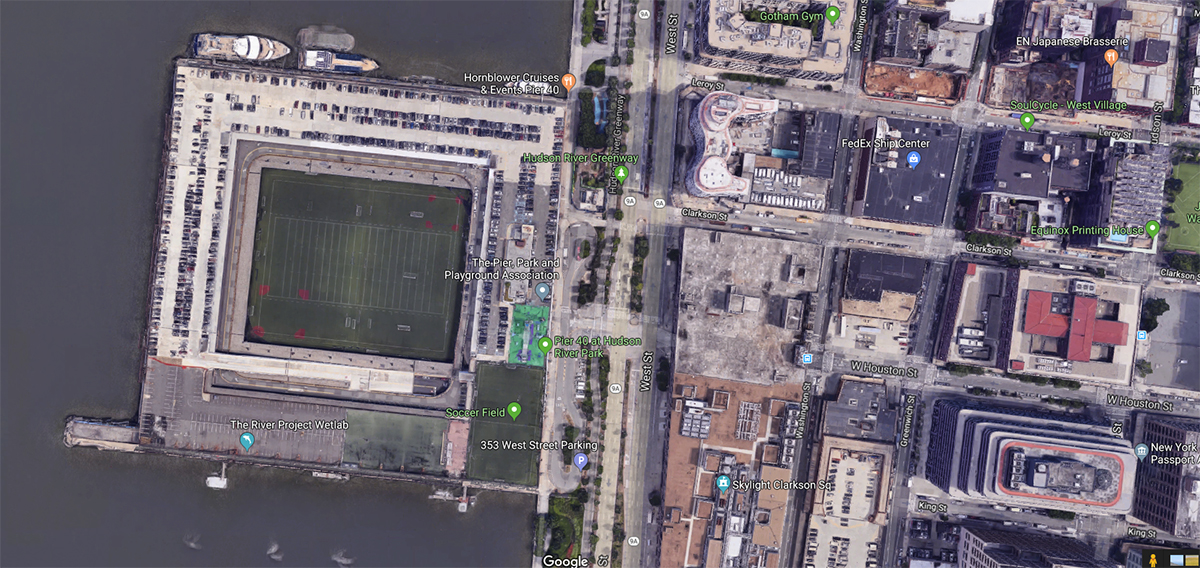Building an 880,000 square-foot office building atop Pier 40 in the Hudson River is a terrible idea. An even worse idea is Councilwoman Deborah Glick’s hope that a compromise reducing the size to 700,000 square feet should be worth exploring. The purpose of these efforts is to secure additional funds for soccer and Little League baseball being played at the center of the huge pier. To that end The Hudson River Park Trust, which manages the pier, is lobbying the New York State legislature to lengthen the lease time for a potential developer to 99 years, making it attractive for someone to build atop the pier. The New York Times recently supported the proposal on its editorial page.
The first problem with the idea is one of scale. Were Pier 40, a gigantic two and a half acre square, raised to seven or eight stories it will loom over the waterfront. Each face of the building will be a block and a half long. Rather than sensing a park along the river we will see a large building blocking some bushes and a bike path behind.
Context and the longer term are important considerations. New York is the world’s most important city sitting astride one of the country’s most important rivers, certainly its most storied and picturesque. Officials and benefactors have struggled for years to join the city to the river. This has often happened in stages. Riverside Park is an excellent example. From Frederick Law Olmsted’s original plans for green space bordering Riverside Drive above the river, the park has grown down to the water in stages to become the treasure it is today. If Riverside Park now that it has matured were ever to need additional funds, would one suggest building an 800,000 square-foot office building in the Hudson River adjacent to the park?
Pier 40 is the newest of dozens of piers which aligned the river during the hey-days of break-bulk shipping. Its huge square shape and size were intended to let cargo ships disgorge freight on three sides. The hopes were that this innovative design would be a model for retaining shipping on the Hudson River at a time when containerization was changing the industry. New ships required 25 to 50 acres per berth. As shippers realized the speed with which they could load and unload containers they also realized they needed much more land to store the boxes. Port activity began moving to Port Newark and Port Elizabeth where ample land, access to a highway, rail lines and an airport made more economic sense. Shipping left and Pier 40 remained, largely unused.
Less than half a century later most of the piers are gone. Some just fell into the river. The Hudson River itself was often the culprit. Engineers call it a hostile environment. As long as piers were economically viable they received maintenance. When shipping left the piers began quickly to deteriorate. Tides and ice often scalloped out the piles. It’s called “hour glassing.” As the Hudson River became cleaner the marine borer, a mollusk that eats wood, has reappeared, chewing on piles, docks and piers — everything in the river made of wood. One pier fell into the river when a gravel barge was tied to its piles. A changing tide tugged at the barge until the pier collapsed.
Waterfront development is seductively attractive to the uninitiated. Chelsea Piers further north along the river is a good example of the costs. Construction was a much greater expense than developers had planned, but maintenance costs were also considerable. As one specific example, as piles shifted, the developers learned they needed to pay attention to a swimming pool, built on one of the piers. It would have been rendered useless if it began cracking from movement. Costs affect revenue, and revenue affects feasibility.
The Hudson River Park Trust is tasked with creating and maintaining a riverfront park. It is not tasked with privatizing the waterfront to do so.
Craig Whitaker is the author of “Architecture and the American Dream” and was author of the plan for Westway & the FBW Plan for the Hoboken Waterfront.


